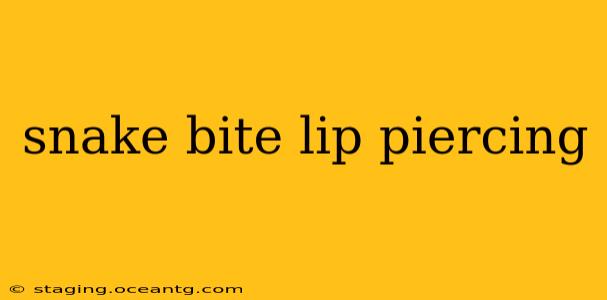The snake bites piercing is a trendy and edgy lip piercing style that's gained significant popularity. This guide delves into everything you need to know about snake bites, from the piercing process itself to aftercare and potential complications. We'll also address common questions surrounding this unique body modification.
What is a Snake Bites piercing?
A snake bites piercing consists of two symmetrical piercings on the lower lip, typically placed just outside the lip's center. They're named "snake bites" because the two piercings resemble the fangs of a snake. This style is considered a relatively low-risk piercing when done correctly by a professional piercer. However, it’s important to understand the potential risks and how to minimize them.
How painful is a snake bites piercing?
The pain level associated with a snake bites piercing is subjective and varies from person to person. Many describe it as a sharp, quick pinch, followed by a dull ache. The pain level is typically manageable and short-lived, but the discomfort will depend on your pain tolerance and the piercer's technique. Using a numbing agent can help alleviate some discomfort.
How long does a snake bites piercing take to heal?
Healing times for snake bites piercings generally range from 6 to 8 weeks for the initial healing phase. However, complete healing can take up to 6 to 12 months. During this time, it's crucial to follow proper aftercare instructions to prevent infection and complications. Factors like your body's healing capabilities and adherence to aftercare routines can influence the overall healing duration.
What are the risks of getting a snake bites piercing?
While generally safe when performed by a licensed professional, snake bites piercings, like any piercing, carry potential risks, including:
- Infection: This is the most common risk, especially if proper aftercare is not followed.
- Bleeding: Minor bleeding is expected during the piercing, but excessive bleeding can indicate a problem.
- Swelling and bruising: These are typical in the initial days after the piercing.
- Nerve damage: Although rare, there's a small chance of damaging nerves in the lip area, potentially leading to numbness or tingling.
- Rejection: The body may reject the piercing jewelry, leading to the piercing closing up.
- Migration: The piercing may migrate slightly from its original position.
- Keloid scarring: This is the formation of excessive scar tissue.
- Allergies: Allergic reactions to the piercing jewelry are possible.
Choosing a Reputable Piercer is Crucial: Minimizing these risks significantly depends on selecting a licensed and experienced professional who adheres to strict sterilization protocols.
How much does a snake bites piercing cost?
The cost of a snake bites piercing varies depending on the location, piercer's experience, and the type of jewelry used. Expect to pay anywhere from $40 to $100 or more per piercing.
What jewelry is best for snake bites piercings?
The most suitable jewelry for initial healing is typically implant-grade titanium or labret studs. These materials are biocompatible and less likely to cause allergic reactions. Avoid using jewelry made from nickel or other materials that can irritate the piercing. Your piercer will advise on the best jewelry choice for your specific needs.
How do I care for my snake bites piercing?
Proper aftercare is paramount to ensure a smooth healing process and prevent complications. This typically involves:
- Gentle cleaning: Rinse your mouth with a saline solution several times a day.
- Avoid touching: Keep your hands away from the piercing to prevent infection.
- Dietary adjustments: Avoid spicy or acidic foods that can irritate the piercing.
- Oral hygiene: Maintain excellent oral hygiene by brushing and flossing regularly.
- Avoid smoking and alcohol: These substances can hinder the healing process.
Can I change my snake bites jewelry myself?
No. It's crucial to wait until your piercer deems your piercing healed enough before attempting to change the jewelry yourself. Prematurely changing jewelry can increase the risk of infection and damage the healing tissue.
What are the best practices for healing a snake bites piercing?
The best practices for healing snake bites piercings include choosing a reputable piercer, following aftercare instructions diligently, and maintaining a healthy lifestyle. Patience is key, as the healing process can take several months. If you experience any signs of infection (increased pain, swelling, redness, pus), seek immediate medical attention.
This guide provides a comprehensive overview of snake bites piercings. Remember, proper research and choosing a reputable piercer are key to a safe and successful piercing experience. Always consult with your piercer for personalized advice and aftercare instructions.
